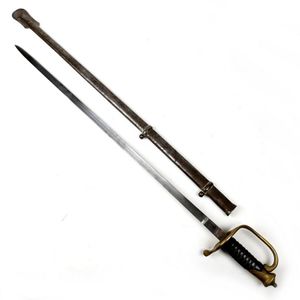Shinto Wakizashi by Yamashiro Kuni Ju Fujiwara Tsunahiro
You must be a subscriber, and be logged in to view price and dealer details.
Subscribe Now to view actual auction price for this item
When you subscribe, you have the option of setting the currency in which to display prices to $Au, $US, $NZ or Stg.
- Shakudo - Japanese shakudo is a traditional alloy that has been used in Japan for centuries. It is primarily composed of copper and gold, with the copper serving as the base metal and the gold adding a yellowish hue to the alloy. Shakudo is known for its beautiful dark blue-black or black colour, which is achieved through the addition of a small amount of a patina-inducing element like silver or arsenic.
The word "shakudo" itself can be translated as "red copper" in Japanese, referring to the reddish-brown color of the pure copper base metal before it is patinated. The gold content in shakudo is usually around 4-10%, but this can vary depending on the specific purpose or desired appearance.
Shakudo has been traditionally used in various forms of decorative arts and crafts in Japan. It is particularly associated with metalwork, including sword fittings (such as tsuba, menuki, and kashira), jewelry, and small ornamental objects. The alloy's dark color provides a striking contrast to other metals like silver or gold, making it ideal for intricate inlay work or as a background for other decorative elements. - Circa - A Latin term meaning 'about', often used in the antique trade to give an approximate date for the piece, usually considered to be five years on either side of the circa year. Thus, circa 1900 means the piece was made about 1900, probably between 1895 and 1905. The expression is sometimes abbreviated to c.1900.
- Edo Period, Japan - The Edo period in Japan lasted from 1603 to 1868. During this time, Japan was ruled by the Tokugawa shogunate, a military government led by the Tokugawa family. The Edo period is characterized by a period of relative peace, stability, and economic growth, as well as by the development of a distinctive culture and society.
During the Edo period, the capital of Japan was moved from Kyoto to Edo (modern-day Tokyo), and the country became increasingly isolated from the rest of the world. The shogunate implemented strict policies to maintain control, including the restriction of foreign trade and travel. However, despite this isolation, the Edo period saw significant cultural and artistic development, including the emergence of the ukiyo-e woodblock print tradition, the growth of Kabuki theater, and the flourishing of a vibrant merchant culture.
The Edo period ended with the Meiji Restoration of 1868, which saw the collapse of the shogunate and the restoration of imperial rule. - Manner of .... / Style of ..... - A cataloguing term where the item, in the opinion of the cataloguer is a work in the style of the artist, craftsman or designer, possibly of a later period.
This item has been included into following indexes:
Visually similar items

Koto period Katana attributed to Su Mihara dated pre 1596, unsigned but attributed to Su Mihara by Nbthk Hozon Kanteisho, circa 1550. in full Japanese polish. Blade curve, straight temper line & well aged original tang are typical of the late Muromachi per

An Indian copy of a regimental officer's sword, with brass hilt and guard, steel scabbard. Overall length 102 cm.

Edo Jumyo Wakizashi Nihon Bijutsu Token Hozon Kyokai Kanteisho circa 1800, unsigned wakizashi from Mino Province, attributed to Jumyo school by recent Nihon Bijutsu Token Hozon Kyokai kanteisho, with an appraisal & authentication certificate, in full polis

Koto Wakizashi Ubu by Kaneharu Saku Mino province, Muromachi period. Blade shape of hirazukure, iroi mune, sakizori, bohi. Tempering of gunome notare midare, togare, deep ashi iri, yo, choji, nado. Boshi is jizo. Forging is itame hada, some looseness, fain
